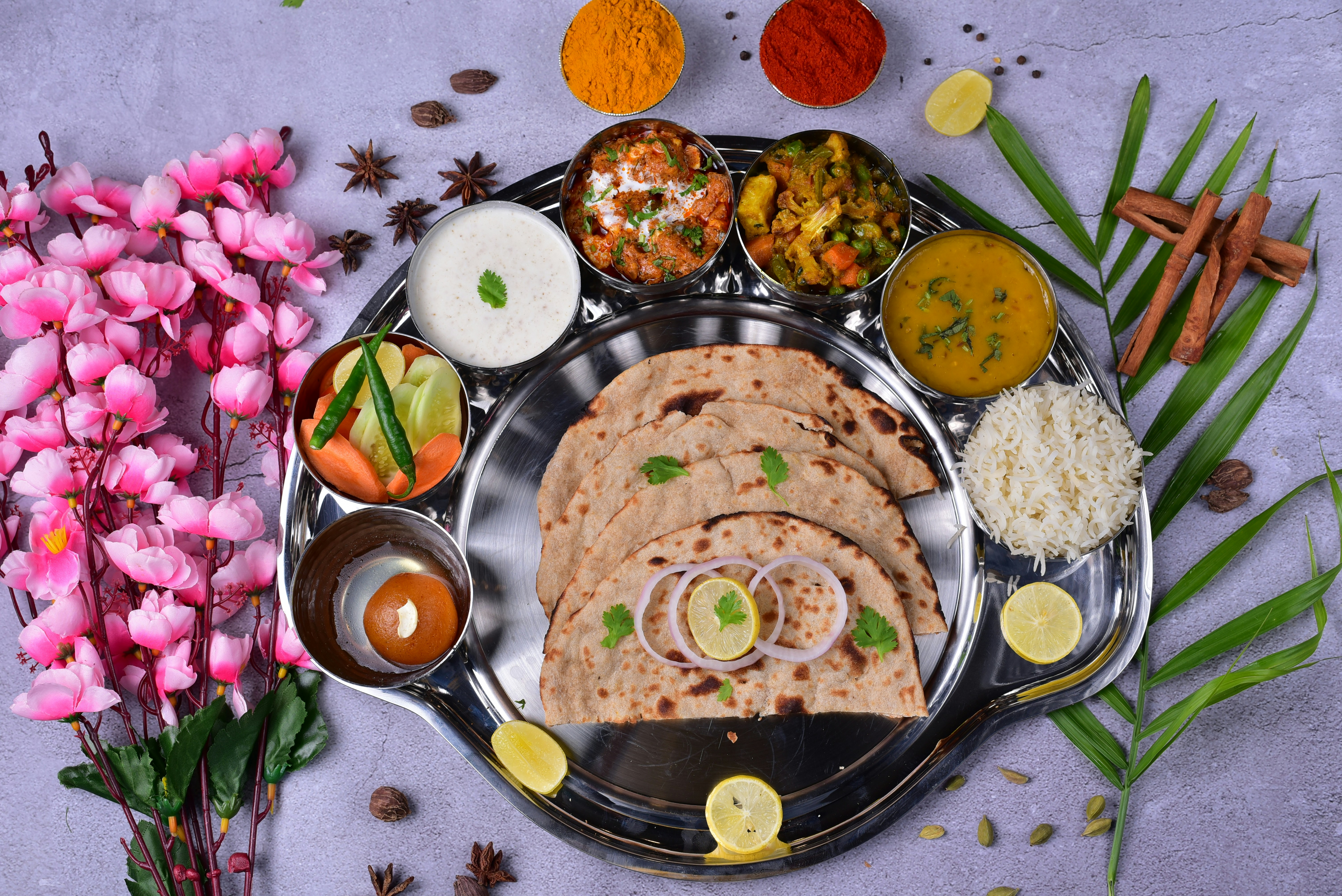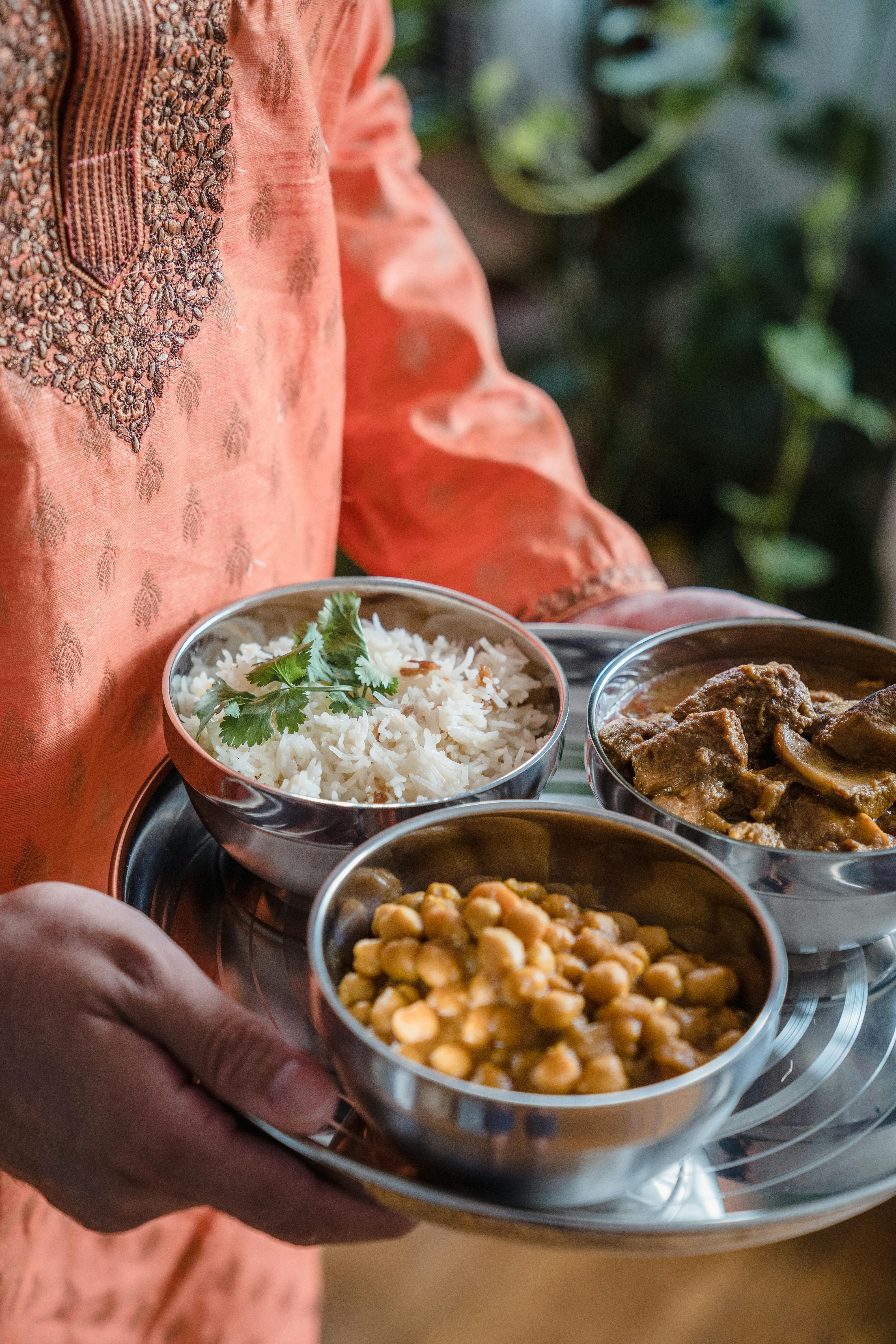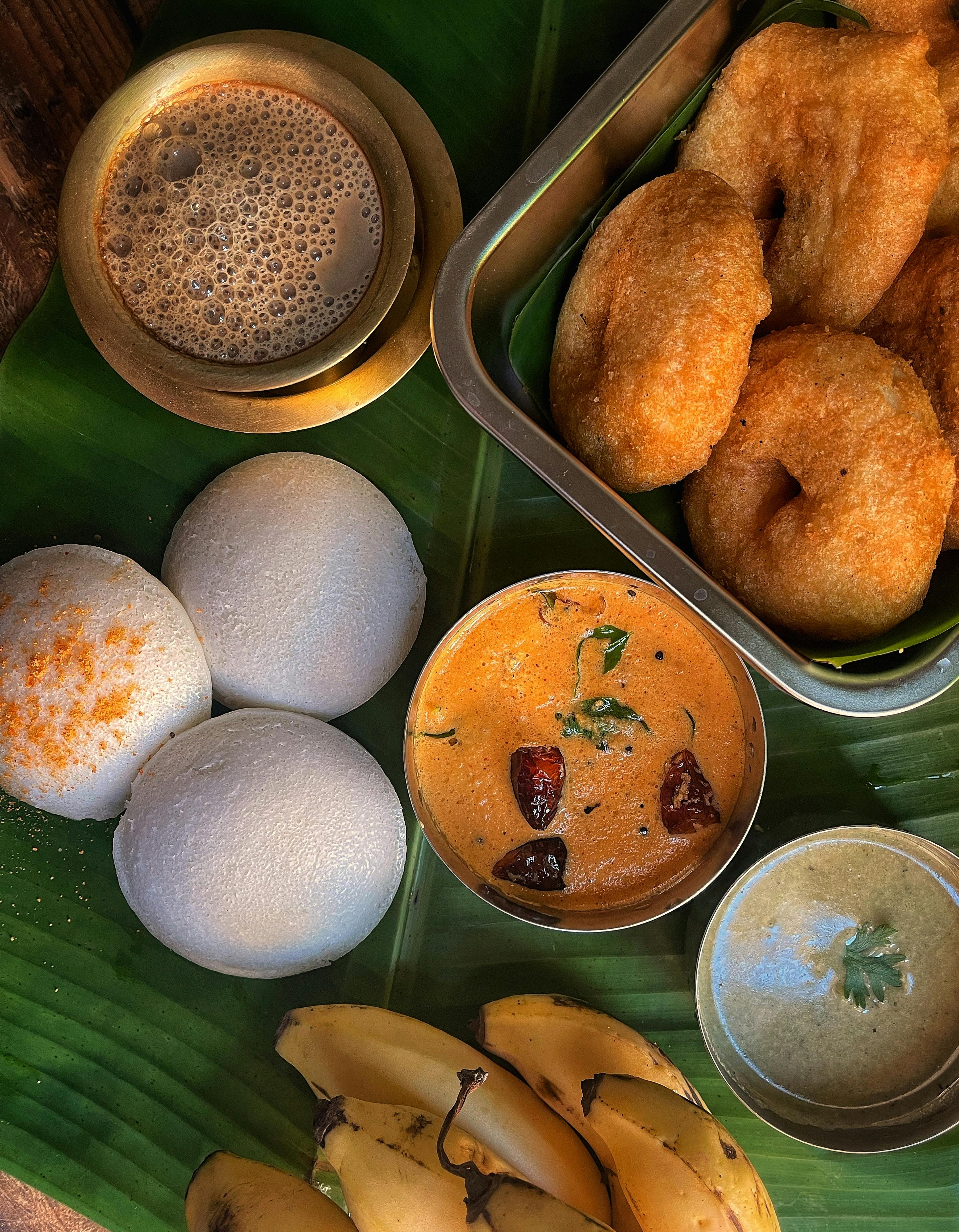
North vs. South: Understanding the Two Major Indian Cuisine Styles
When you’re new to Indian cuisine, the diversity can be overwhelming. India is a vast country with 28 states and 8 union territories, each with its own culinary traditions. However, for beginners, understanding the two major culinary divisions—North and South Indian cuisines—provides an excellent foundation for exploring this rich food culture.
These two culinary traditions differ significantly in their ingredients, cooking techniques, flavor profiles, and even dining customs. This guide will walk you through these differences, helping you navigate Indian restaurant menus with greater confidence and appreciation.
Geographical and Cultural Influences
Before diving into the culinary differences, it’s helpful to understand the geographical and cultural factors that shaped these distinct cooking styles:
North Indian Influences
North Indian cuisine encompasses regions including Punjab, Uttar Pradesh, Kashmir, Rajasthan, and Delhi. This region has historically experienced more foreign influences due to invasions and trade routes:
- The Mughal Empire (16th-19th centuries) brought Persian, Turkish, and Arabic influences
- The colder climate in northern regions influenced cooking methods and ingredient preservation
- Wheat cultivation flourishes in the northern plains, making it the staple grain
- The Silk Road trade routes introduced new spices and cooking techniques
South Indian Influences
South Indian cuisine includes the states of Tamil Nadu, Kerala, Karnataka, Andhra Pradesh, and Telangana. This region has been more insulated from foreign influences:
- The tropical climate supports rice cultivation and coconut growth
- Coastal geography provides abundant access to seafood and coconuts
- Ancient Dravidian culture has maintained continuous culinary traditions for thousands of years
- Strong Hindu temple culture influenced vegetarian cooking techniques and traditions
Fundamental Differences in Ingredients
The most striking difference between North and South Indian cuisines lies in their fundamental ingredients:
Staple Grains: Wheat vs. Rice
North Indian Cuisine: Wheat is the primary staple, reflecting the grain’s abundance in the northern plains. This manifests in various bread forms:
- Roti/Chapati: Unleavened whole wheat flatbread
- Naan: Leavened flatbread baked in a tandoor (clay oven)
- Paratha: Layered flatbread, often stuffed with vegetables or meat
- Kulcha: Leavened bread made with refined flour
While rice is consumed in North India, it’s often reserved for special dishes like biryani or pulao rather than daily meals.
South Indian Cuisine: Rice dominates as the staple grain, used in countless preparations:
- Plain steamed rice: Accompanies most meals
- Idli: Steamed rice cakes made from fermented rice and lentil batter
- Dosa: Thin, crispy pancakes made from fermented rice and lentil batter
- Uttapam: Thicker pancakes with toppings, made from the same batter as dosa
- Various rice dishes: Lemon rice, tamarind rice, coconut rice, etc.
Wheat products exist in South India but are less common in traditional cuisine.
Dairy Usage
North Indian Cuisine: Dairy products feature prominently, influenced by the pastoral traditions of regions like Punjab:
- Ghee (clarified butter) is the preferred cooking fat
- Paneer (fresh cheese) is used in many vegetarian dishes
- Yogurt appears in marinades, sauces, and as a side dish (raita)
- Cream enriches many gravies, especially in Mughlai cuisine
South Indian Cuisine: Dairy is used more sparingly:
- Coconut oil is often the preferred cooking fat instead of ghee
- Yogurt is used primarily as an accompaniment or in rice dishes
- Coconut milk often replaces cream in creating richness
Coconut Usage
North Indian Cuisine: Coconut is rarely used in traditional North Indian dishes, appearing occasionally in some desserts or specialty regional dishes.
South Indian Cuisine: Coconut is fundamental to South Indian cooking:
- Fresh grated coconut is used as garnish
- Coconut milk adds richness to curries
- Coconut oil is a primary cooking medium
- Ground coconut forms the base of many chutneys and gravies
Cooking Methods and Techniques
The cooking techniques employed in these two regions differ significantly, influencing the texture and flavor of dishes:
North Indian Cooking Techniques
- Tandoor cooking: The clay oven (tandoor) is used to make breads like naan and roast marinated meats (tandoori chicken, seekh kebab)
- Slow simmering: Many North Indian curries are simmered slowly, allowing flavors to meld
- Dum cooking: A slow-cooking method where food is sealed in a pot with its own steam (used for biryani and some curries)
- Tarka/Tadka: While used throughout India, in North Indian cuisine this tempering of spices in hot oil often happens at the beginning of cooking
South Indian Cooking Techniques
- Steaming: Used for dishes like idli (steamed rice cakes)
- Fermentation: Many South Indian staples rely on fermentation of rice and lentil batters (idli, dosa)
- Stir-frying: Quick cooking in minimal oil is common for vegetable preparations
- Tadka: In South Indian cuisine, tempering with mustard seeds, curry leaves, and dried chilies often happens at the end of cooking
Flavor Profiles and Spice Differences
The flavor profiles of North and South Indian cuisines are distinctly different, offering contrasting culinary experiences:
North Indian Flavor Profile
- Rich and creamy: Many dishes feature dairy to create luscious textures
- Warming spices: Greater use of garam masala, featuring cinnamon, cardamom, cloves
- Moderate heat: Chilies are used for flavor but extreme heat is less common
- Onion and tomato bases: Many gravies start with this foundation
- Dried fruits and nuts: Used in special dishes, reflecting Persian influence
South Indian Flavor Profile
- Tangy and spicy: Greater use of tamarind, tomatoes, and chilies
- Lighter and sharper: Less reliance on dairy creates brighter flavors
- Higher heat levels: Generally spicier, especially in Andhra cuisine
- Coconut sweetness: Balances the tanginess and heat
- Curry leaves and mustard seeds: Create distinctive aromatic profiles
Key Spice Differences
While many spices are used throughout India, certain spices are more prominent in each region:
Spices More Prominent in North Indian Cuisine:
- Garam masala (a warming spice blend)
- Dried fenugreek leaves (kasuri methi)
- Saffron
- Cardamom
- Cinnamon
Spices More Prominent in South Indian Cuisine:
- Curry leaves (a fresh herb, not related to curry powder)
- Black mustard seeds
- Asafoetida (hing)
- Tamarind
- Dried red chilies
Bread vs. Rice as the Base Starch
The difference in staple starches between North and South India goes beyond mere ingredient preference—it reflects deeper cultural and practical considerations:
Cultural and Historical Reasons
The wheat-rice divide has deep historical roots:
- Northern India’s climate and soil are ideal for wheat cultivation
- Southern India’s tropical climate and monsoon patterns favor rice cultivation
- Trade routes brought Middle Eastern bread-making techniques to North India
- Ancient Tamil literature from 2000+ years ago already mentions rice as the staple food
Practical Implications for Diners
This staple difference affects how meals are structured and eaten:
- North Indian meals typically involve using bread to scoop up curries and dry dishes
- South Indian meals traditionally mix rice with curries, often eating with the hand
- North Indian thalis (meal platters) feature bread as the central starch
- South Indian meals are often served on banana leaves with rice at the center
Signature Dishes from Each Region
To truly understand the difference between these cuisines, it helps to know their iconic dishes:
Iconic North Indian Dishes
- Butter Chicken: Tandoor-roasted chicken in a rich, tomato-based gravy with butter and cream
- Rogan Josh: Aromatic lamb curry with a distinctive red color from Kashmiri chilies
- Chole Bhature: Spiced chickpea curry served with fried bread
- Dal Makhani: Slow-cooked black lentils with butter and cream
- Paneer Tikka: Marinated and grilled Indian cottage cheese
- Biryani: Layered rice dish with meat, vegetables, and aromatic spices
Iconic South Indian Dishes
- Masala Dosa: Crispy rice and lentil crepe filled with spiced potatoes
- Idli Sambar: Steamed rice cakes served with lentil soup and chutney
- Rasam: Tangy, spicy tamarind soup
- Appam with Stew: Lacy rice pancakes served with coconut-based stew
- Chettinad Chicken: Intensely spiced chicken curry from Tamil Nadu
- Hyderabadi Biryani: A South Indian variation of the layered rice dish
How to Identify a North or South Indian Restaurant
When choosing an Indian restaurant, it helps to know whether it specializes in Northern or Southern cuisine:
Identifying North Indian Restaurants
Look for these clues:
- Menu prominently features naan, roti, and other breads
- Tandoori dishes are highlighted
- Paneer (cheese) dishes are abundant
- Dishes like butter chicken, dal makhani, and palak paneer appear
- Decor may feature Mughal-inspired elements
- Restaurant name might include terms like “Punjabi,” “Mughlai,” or “Tandoor”
Identifying South Indian Restaurants
Look for these indicators:
- Menu features dosa, idli, vada, and uttapam prominently
- Coconut chutney and sambar are standard accompaniments
- Rice varieties (lemon rice, tamarind rice) are offered
- Restaurant name might include terms like “Udupi,” “Chettinad,” or “Dosa”
- Thalis (set meals) are served on banana leaves or metal plates with compartments
- Filter coffee is on the beverage menu
Hybrid Restaurants
Many Indian restaurants in the West offer both North and South Indian dishes. In these establishments:
- The menu is typically divided into clear sections
- North Indian dishes dominate in most “general” Indian restaurants
- South Indian items might be limited to a few popular dishes like dosa and idli
Recommended Starter Dishes from Each Cuisine Style
For newcomers to Indian cuisine, here are approachable dishes from each tradition:
North Indian Starter Dishes for Beginners
- Butter Chicken: Mild, creamy tomato-based curry with tandoor-cooked chicken
- Dal Makhani: Creamy black lentil dish, rich but not spicy
- Paneer Tikka: Marinated and grilled cheese cubes with a smoky flavor
- Malai Kofta: Vegetable and cheese dumplings in a mild, creamy sauce
- Naan: Soft, leavened flatbread perfect for scooping curries
South Indian Starter Dishes for Beginners
- Plain Dosa: Crispy rice and lentil crepe served with chutney and sambar
- Idli: Steamed rice cakes with a mild, slightly tangy flavor
- Coconut Rice: Basmati rice flavored with coconut, mustard seeds, and curry leaves
- Vegetable Korma: Mixed vegetables in a mild coconut sauce
- Appam: Bowl-shaped rice pancakes with soft centers and crispy edges
Dining Customs and Etiquette Differences
Even the way food is served and eaten differs between North and South India:
North Indian Dining Customs
- Food is typically served in separate bowls
- Bread is torn with the right hand and used to scoop up curries
- Rice is often served as a separate course or side dish
- Meals traditionally end with chaas (spiced buttermilk) to aid digestion
South Indian Dining Customs
- Traditional meals are served on banana leaves or thali plates with compartments
- Rice forms the base onto which small portions of curries and sides are mixed
- Food is often mixed with the fingers of the right hand
- Meals traditionally begin with something sweet and end with yogurt rice
- Filter coffee often concludes the meal
Beyond the North-South Divide
While the North-South classification provides a helpful starting point, it’s important to note that Indian cuisine is far more diverse:
Regional Variations
Within both North and South India, there are numerous regional cuisines with their own distinct characteristics:
- Eastern India (Bengal, Odisha) features mustard oil, fish, and rice
- Western India (Gujarat, Maharashtra) offers distinctive vegetarian traditions
- Central India has its own unique tribal and regional cuisines
- Even within South India, Kerala, Tamil Nadu, Andhra Pradesh, and Karnataka have distinct culinary identities
Fusion and Evolution
Modern Indian cuisine continues to evolve:
- Chefs are creating innovative fusion dishes blending regional traditions
- Urban Indian cuisine often transcends regional boundaries
- Indian diaspora communities have developed their own adaptations
Conclusion: Appreciating India’s Culinary Diversity
Understanding the differences between North and South Indian cuisines provides a valuable framework for exploring one of the world’s most diverse and sophisticated food cultures. These distinctions reflect thousands of years of history, geography, climate, and cultural exchange.
As a newcomer to Indian cuisine, recognizing these regional differences will enhance your dining experience and help you make more informed choices when ordering. Whether you prefer the rich, creamy curries of the North or the tangy, spicy flavors of the South, Indian cuisine offers a lifetime of culinary exploration.
Remember that these categories are just the beginning—each state and even city in India has its own culinary treasures waiting to be discovered. The North-South framework is your entry point into a fascinating world of flavors, techniques, and traditions that have evolved over millennia.
Ready to put your knowledge into practice? Check out our companion article, “How to Order Indian Food: A Step-by-Step Guide for First-Timers,” for practical advice on navigating your next Indian restaurant visit.
Related Articles

The Royal Heritage of North Indian Cuisine
Trace the Mughal influences, cooking techniques, and cultural significance behind North India's rich...

A Journey Through South Indian Cuisine: Beyond Dosas and Idlis
Discover the incredible diversity of South Indian cooking across Tamil Nadu, Kerala, Karnataka, and ...